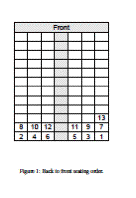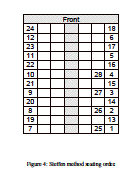A study in the Journal of Air Transport Management revealed that the boarding procedure used by most airlines today is the least efficient and the most efficient strategy would to have passengers boarding in alternate rows.
The study, conducted by Jason Steffen, an astrophysicist at Fermi National Laboratory in Illinois, took place in a mock fuselage, with 12 rows of six seats and a single aisle. Five methods were used to board 72 passengers and the average time for each method was recorded.
The current, commonly used method of boarding passengers from the rear rows first and gradually moving forward, called the Reverse Pyramid, takes the longest time because it leads to higher aisle and seat interferences where “passengers must either wait or traverse each other” in the aisle or within a row of seats, particularly on single aisle aircraft. On average, boarding from back to front, either by rows or in blocks, takes over six minutes and the latter is the slowest method, taking up to 6.54 minutes.


Another method that was tested, called the Wilma method, boards passengers in window seats first, followed by those in middle and aisle seats. This method reduces seat inferences and thus makes boarding more efficient than the Reverse Pyramid method. On average, boarding took 4.13 minutes when the Wilma method was adopted.

The study proposes the Steffen method, named after the researcher, which would organise boarding based on alternate rows thus reducing both seat and aisle interferences. For example, passengers in seats 6A, 8A, 10A and 12A would board first to reduce aisle interferences and enable “multiple passengers stowing their luggage simultaneously,” states the study. Boarding with this method took the shortest time: 3.36 minutes.

When applied on larger aircraft, the Steffen method would still be the fastest. “If the airplane is twice as long, the time savings will be nearly twice as much since the density of luggage stowing passengers will remain the same” on all airplanes. Consequentially, the study states, this could lead to large monetary savings for carriers, “as much as US$110,000,000 annually per carrier.”
To read the full study, click here.
Alisha Haridasani








